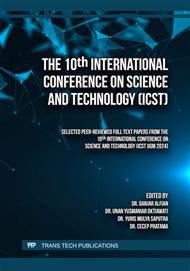[1]
Ismanto, Hidayah, F., & Kristinanti. (2020, Februari). Pemodelan Proses Bisnis Menggunakan Business Process Modelling Notation (BPMN) (Studi Kasus Unit Penelitian dan Pengabdian Kepada Masyarakat (P2KM) Akademi Komunitas Negeri Putra Sang Fajar Blitar). BRILIANT: Jurnal Riset dan Konseptual, 5, 69-76.
DOI: 10.28926/briliant.v5i1.430
Google Scholar
[2]
Huang, F., Ni, F., Liu, J., Yang, F., & Zhu, j. (2022). A Colored Petri Net Executable Modeling Approach for a Data Flow Well-Structured BPMN Process Model. IEEE Access, 10
DOI: 10.1109/ACCESS.2022.3198969
Google Scholar
[3]
Olberg, P. v., & Strey, L. (2022). Approach to Generating Functional Test Cases from BPMN Process Diagrams. Requirements Engineering Conference Workshops (REW)
DOI: 10.1109/REW56159.2022.00042
Google Scholar
[4]
Ivanchikj, A., Serbout, S., & Pautasso, C. (2020). From Text to Visual BPMN Process Models: Design and Evaluation. Proceedings of the 23rd ACM/IEEE International Conference on Model Driven Engineering Languages and Systems (pp.229-239). Montreal, Canada: ACM Digital Library
DOI: 10.1145/3365438.3410990
Google Scholar
[5]
Honkisz, K., Kluza, K., & Wiśniewski, P. (2018). A Concept for Generating Business Process Models from Natural Language Description. International Conference on Knowledge Science, Engineering and Management (p.91–103). Krakow: Springer Nature Switzerland AG
DOI: 10.1007/978-3-319-99365-2_8
Google Scholar
[6]
Azevedo, L. G., Rodrigues, R. d., & Revoredo, K. (2018). BPMN Model and Text Instructions Automatic Synchronization. International Conference on Enterprise Information Systems (pp.484-491). SciTePress
DOI: 10.5220/0006809604840491
Google Scholar
[7]
Friedrich, F., Mendling, J., & Puhlmann, F. (2011). Process Model Generation from Natural Language Text. Advanced Information Systems Engineering - 23rd International Conference, CAiSE. London: Researchgate
DOI: 10.1007/978-3-642-21640-4_36
Google Scholar
[8]
Sonbol, R., Rebdawi, G., & Ghneim, N. (2023). A Machine Translation Like Approach to Generate Business Process Model from Textual Description. SN Computer Science, 4(291)
DOI: 10.1007/s42979-023-01742-z
Google Scholar
[9]
Gonçalves, J., Santoro, F., & Baião, F. (2011). Let me tell you a story - on how to build process models. Journal of Universal Computer Science, 17(2), 276 - 295. Retrieved from https://www.scopus.com/inward/record.uri?eid=2-s2.0-79955487950&partnerID=40&md5=04f55028bd18f1aea5ae07064b2447c6
Google Scholar
[10]
Sawant, K. P., Roy, S., Sripathi, S., Plesse, F., & Sajeev, A. (2014). Deriving Requirements Model from Textual Use Cases. Companion Proceedings of the 36th International Conference on Software Engineering (p.235–244). Hyderabad: ACM Digital Library
DOI: 10.1145/2591062.2591193
Google Scholar
[11]
Epure, E. V., Martín-Rodilla, P., Hug, C., Deneckère, R., & Salinesi, C. (2015). Automatic process model discovery from textual methodologies. IEEE 9th International Conference on Research Challenges in Information Science (RCIS) (pp.19-30). Athens: Institute of Electrical and Electronics Engineers Xplore Digital Library
DOI: 10.1109/RCIS.2015.7128860
Google Scholar
[12]
Javed, M., & Lin, Y. (2021). iMER: Iterative process of entity relationship and business process model extraction from the requirements. Information and Software Technology, 135
DOI: 10.1016/j.infsof.2021.106558
Google Scholar
[13]
Tangkawarow, I. R., Sarno, R., & Siahaan, D. (2020). Modeling Business Rule Parallelism by Introducing Inclusive and Complex Gateways in Semantics of Business Vocabulary and Rules. International Journal of Intelligent Engineering and Systems, 14, 281-295
DOI: 10.22266/ijies2021.0228.27
Google Scholar
[14]
Ferreira, R. C., Thom, L. H., & Fantinato, M. (2017). A Semi-automatic Approach to Identify Business Process Elements in Natural Language Texts. e 19th International Conference on Enterprise Information Systems (ICEIS 2017). pp.250-261. SCITEPRESS – Science and Technology Publications
DOI: 10.5220/0006305902500261
Google Scholar
[15]
Han, X., Hu , L., Mei, L., Dang, Y., Agarwal, S., Zhou, X., & Hu, P. (2020). A-BPS: Automatic Business Process Discovery Service using Ordered Neurons LSTM. IEEE International Conference on Web Services (ICWS) (pp.428-432). Beijing, China: Institute of Electrical and Electronics Engineers Digital Library
DOI: 10.1109/ICWS49710.2020.00063
Google Scholar
[16]
Mustansir, A., Shahzad, K., & Malik, M. K. (2020). AutoEPRS-20: Extracting Business Process Redesign Suggestions from Natural Language Text. IEEE/ACM International Conference on Automated Software Engineering Workshops (ASEW) (pp.118-124). Melbourne, VIC, Australia: Institute of Electrical and Electronics Engineers Digital Library
DOI: 10.1145/3417113.3423374
Google Scholar
[17]
Sintoris, K., & Vergidis, K. (2017). Extracting Business Process Models Using Natural Language Processing (NLP) Techniques. 2017 IEEE 19th Conference on Business Informatics (CBI), (pp.135-139). Thessaloniki, Greece: Institute of Electrical and Electronics Engineers Digital Library
DOI: 10.1109/CBI.2017.41
Google Scholar
[18]
Quishpi, L., Carmona, J., & Padro, L. (2020). Extracting Annotations from Textual Descriptions of Processes. Business Process Management. "Business Process Management, 18th International Conference" (pp.184-201). Berlín: SpringerLink
DOI: 10.1007/978-3-030-58666-9_11
Google Scholar
[19]
Kitchenham, B., & Charters, S. (2007). Guidelines for performing Systematic Literature Reviews in Software Engineering.
Google Scholar


